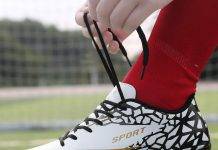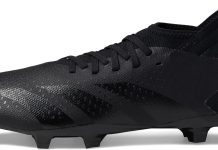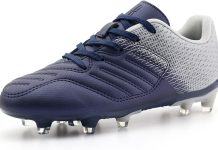Let’s clear up the confusion once and for all – are soccer boots and cleats the same thing? You’re not alone if you’ve ever pondered this question as you gear up for a game.
Soccer enthusiasts worldwide debate whether the terms can be used interchangeably or if there are subtle differences that distinguish one from the other.
In this article, we’ll explore the world of soccer footwear to shed light on this ongoing debate.
So, lace up your boots or cleats, grab a seat, and get ready to uncover the truth behind these essential pieces of soccer equipment.
Materials
Review contents
Leather
Leather is a popular material used in soccer boots for its durability and flexibility. It molds to your foot over time, providing a comfortable fit. Leather boots are more expensive but offer excellent ball control due to their softness.
Synthetic materials
Synthetic materials, such as microfiber and synthetic leather, are commonly used in soccer boots. These materials are lightweight and offer more durability than leather. They are also easier to maintain, as they can be easily cleaned and dried. Synthetic boots are often more affordable than leather boots.
Mesh
Mesh panels are featured in many modern soccer boots, providing breathability and improved airflow. This helps to keep your feet cool and dry during intense matches. Boots with mesh panels are lightweight and comfortable, making them popular among players.
Design
Shape
The shape of a soccer boot plays a crucial role in performance. Boots come in various shapes, including round, narrow, and comprehensive. It’s essential to find a shape that suits your foot’s natural shape to ensure a comfortable fit and optimal performance on the field.
Weight
The weight of a soccer boot can significantly impact your speed and agility on the field. Lighter boots allow quicker movement and acceleration, making them popular among attacking players. On the other hand, heavier boots provide more stability and support, making them suitable for defensive players.
Studs
Studs are the protrusions on the sole of the soccer boot that provide traction and grip on different playing surfaces. There are various studs, including conical, bladed, and studless boots. The choice of studs depends on the playing surface and personal preference.
Laces
Laces are crucial in securing the boot to your feet and ensuring a snug fit. The positioning and style of laces can vary between different soccer boot models. Some boots feature traditional laces, while others may have a laceless design for a cleaner, striking surface.
Purpose
Traction
One of the primary purposes of soccer boots is to provide traction on the field. The studs or cleats on the boot’s sole dig into the ground, giving you a grip and preventing slips. The type of studs used will vary depending on the playing surface, with different boots designed for firm ground, soft ground, artificial ground, and indoor surfaces.
Stability
Soccer boots also provide stability during quick movements and changes in direction. The design of the boot, such as the shape, weight, and stud configuration, can contribute to stability. Stability prevents ankle rolls and injuries, especially when navigating uneven or slippery playing surfaces.
Protection
Soccer boots offer protection to your feet during the game. The materials used in the boot’s construction, such as leather or synthetic materials, provide a cushioned and supportive barrier between your feet and the ball. This helps to absorb the impact of kicks and tackles.
Types
Firm ground boots
Firm ground boots are the most common soccer boots designed for natural grass or firm playing surfaces. These boots typically have conical studs that provide traction without excessive grip, allowing players to push off the ground and make quick turns.
Soft ground boots
Soft ground boots are specialized for wet or muddy conditions. They are equipped with longer studs to provide better traction in slippery conditions. The longer studs penetrate the softer ground, preventing players from slipping during heavy rainfall or on waterlogged pitches.
Artificial ground boots
Artificial ground boots are designed specifically for artificial turf or synthetic grass surfaces. These boots have shorter studs or a series of small rubber studs or blades that grip onto the artificial grass, providing stability and preventing slips.
Indoor boots
Indoor boots are designed for indoor or futsal courts. They feature a flat, non-marking rubber sole that gives players better control and grip on the smooth indoor surface. Indoor boots are often lighter and more flexible than outdoor boots.
Specialized Boots
Astro turf boots
Astro turf boots are designed for playing on astro turf surfaces. These boots have small rubber studs or small blades that grip onto the artificial grass, providing traction and stability. They are lightweight and often have a low-cut design for better agility on artificial turf.
Turf boots
Turf boots are designed for playing on artificial turf or short, hard surfaces. These boots have many small rubber studs that grip onto the artificial turf, providing optimal traction and stability. They are often more durable and have extra padding to handle the hard surface.
Futsal boots
Futsal boots are specifically designed for the fast-paced indoor game of futsal. They have a flat, non-marking rubber sole that gives excellent control and grip on the smooth indoor surface. Futsal boots are lightweight and often feature a low-cut design for better agility and maneuverability.
Brands
Nike
Nike is one of the leading brands in the soccer boot industry, known for its innovative designs and cutting-edge technology. Nike offers various soccer boots suitable for various playing styles and preferences. Their boots are often praised for their comfort, durability, and performance-enhancing features.
Adidas
Adidas is another famous brand known for its high-quality soccer boots. Adidas boots are known for their exceptional fit and comfort, thanks to their innovative technologies and materials. They offer a wide range of boots that cater to different playing styles and field conditions.
Puma
Puma is a brand that has made a name for itself in the soccer boot market. Puma boots are known for their stylish designs and innovative features. They offer a variety of boots that provide excellent performance, comfort, and durability.
Under Armour
Under Armour is a brand known for its performance-oriented products, and its soccer boots are no exception. Under Armour, boots are designed to provide optimal performance and support on the field. They are often praised for their excellent traction, comfort, and durability.
Price Range
Entry-level boots
Entry-level soccer boots are typically more affordable and cater to beginner or recreational players. These boots may not have all the advanced features of higher-priced models, but they still provide sufficient comfort and performance for casual play.
Mid-range boots
Mid-range soccer boots offer a balance between performance and affordability. These boots often have additional features and technologies that enhance performance and comfort. They are suitable for intermediate players or those looking for a step up in quality.
High-end boots
High-end soccer boots are top-of-the-line models with the most advanced features and materials. Professional players and serious enthusiasts typically wear these boots. While they come at a higher price, they provide superior performance, durability, and comfort.
Care and Maintenance
Cleaning
Proper cleaning is essential to maintain the longevity and performance of your soccer boots. After each use, remove any excess dirt or mud with a soft brush or cloth. Use warm water and mild soap to clean the upper and sole of the boot, taking care not to soak the boot. Allow them to air dry naturally.
Drying
After cleaning, it’s essential to dry your soccer boots properly. Avoid exposing them to direct heat sources like radiators or sunlight, as this can cause damage to the materials. Instead, stuff the boots with newspaper or a shoe tree to help absorb moisture and maintain their shape. Allow them to dry in a well-ventilated area.
Storage
To preserve the shape and condition of your soccer boots, store them in a cool, dry place. Avoid keeping them damp, as this can lead to mold or mildew growth. Using a boot bag or keeping them in their original box is also advisable to protect them from dust and scratches.
Boot Regulations
League Regulations
Different soccer leagues may have specific regulations regarding boot design and features. For example, some leagues may require players to wear boots with non-metallic studs or have a specific stud length. Players need to familiarize themselves with their league’s regulations to ensure compliance.
International Football Association Board (IFAB)
The International Football Association Board (IFAB) sets the laws for soccer worldwide. While they don’t have specific soccer boot design regulations, they address safety concerns. The IFAB ensures that boots do not have any sharp or dangerous components that could harm players on the field.
Conclusion
Soccer boots significantly affect a player’s performance and comfort on the field. Choosing the right pair of boots requires considering various factors, such as materials, design, purpose, and playing surface. By understanding the different types, brands, and price ranges available, you can make an informed decision and find the perfect pair of soccer boots that suit your style of play. Additionally, proper care and maintenance will ensure that your boots last longer and perform optimally, allowing you to focus on what truly matters – enjoying the beautiful game of soccer.










































